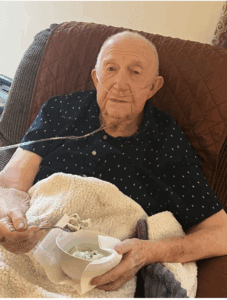“This is not so much an opioid epidemic we are in – it is more a trauma epidemic that people take opiates for.” – My admonition to my therapists and trainees since the early 2010s.
In 2015, I started a pilot project at an addiction treatment agency in order to answer the call of Gabor Maté and Bessel van der Kolk and so many others who note the connection between addiction and trauma. The call to action: Now that we have established the connection, let’s go ahead and treat the trauma directly in addiction care settings.
The question: What if treatment centers utilized EMDR therapy and mindfulness as the central therapies in order to transition from trauma-informed to trauma-focused care? Our rehab was already focused on Buddhist recovery, which was right in my wheelhouse as a longtime practitioner and teacher in the Zen and then Vipassana traditions. I also had just begun providing EMDR therapy training with the Institute for Creative Mindfulness. Having been an EMDR therapist since 2005, and having used it as my primary therapy in any and all situations, I wanted to see what happened if EMDR therapy was placed at the heart of an addiction agency setting (Dansiger, Chabra, Emmel, et al., 2020).
I set about training all the clinicians in EMDR therapy, mindfulness, and Buddhist psychology. We were then able to language the treatment and provide the care through the prism of the Eight Phase Protocol and the Adaptive Information Processing Model, and we could infuse all of it with Buddhist psychology and mindfulness practice. The resulting set of protocols was first called the MET(T)A Method (Mindfulness and EMDR Treatment Template for Addictions), with the “A” later changed from “Addictions” to “Agencies.” Later, MET(T)A Method became MET(T)A Protocol. Since 2015, it was incubated in two centers until 2017 and then manualized, including training in trauma-focused care for all stakeholders including C-Suite (CEO and other executives), admissions, clinical staff, non-clinical staff, clients, and families. In late 2018 we began offering it as an accreditation model internationally. As of this writing, three centers have fully completed the accreditation process, and a number of others have started or are set to begin.
In 2017, Markus and Hornsveld wrote what I consider to be a turning point journal article that presented the EMDR therapy and addiction research to that date, and proposed that the result of 30 years of EMDR practice and research in addiction yielded 15 EMDR therapy modules to utilize in the treatment of addiction. Their work had the effect of validating my thoughts about and the design of the MET(T)A Protocol, as well as making it easier to provide consultation to trainees wanting to know how to treat addiction within the EMDR therapy construct. Based on the principles and practices from my co-authored book with Jamie Marich EMDR Therapy and Mindfulness for Trauma-Focused Care (2018), and my experience training treatment centers and supporting their roll out and maintenance of the MET(T)A Protocol, I present a couple of adjustments to the PEIA. One model is added, and then other modules are reconceptualized, mostly from a treatment planning standpoint. The Eight Phase Standard Protocol and the AIP model lead the way.
The Resourcing Modules
Module One suggests the use of Calm Place and the Resource Development and Installation Protocol, and Module Two focuses on A.J. Popky’s (2010) installation of the Positive Treatment Goals first described in his DeTUR (Desensitization of Triggers and Urge Reduction) Protocol. Our modification to these modules: Resources are anything and everything that is healthy and/or adaptive for the client in front of you. In other words, the resourcing net must be thrown out wider. Just because we may not do bilateral stimulation with resources that are outside the standard resourcing exercises from the EMDR canon does not mean that they are no longer EMDR therapy. We propose that addiction clients in particular may need more time and more options in increasing distress tolerance and widening the affective window of tolerance. This brings us to our one addition to the PEIA model.
Module 2.5: Mindfulness Based Resourcing and Preparation Strategies
Jamie and I (and others on our team) have coined “Phase 2.5” to connote the transition from preparation to reprocessing in the Eight Phase Protocol. Now I have found that the mindfulness-focus of MET(T)A fits right in the “2.5” slot in the PEIA. Since addiction clients have been successfully escaping their thoughts, feelings, and body sensations, we often need to find gentle body-based mindfulness exercises as resources. This can lead to significant symptom relief in the early stages of recovery. Addiction clients will usually need additional time and attention on resourcing for stabilization and for preparation. With a focus on mindfulness, we can tailor this process for individual clients within a treatment center or a private practice setting.
And mindfulness is not only valuable in Phase 1 and 2. Mindfulness work assists in preparation for and the enactment of the reprocessing phases, teaching an addiction client how to answer the ongoing question, “What are you noticing now?” They know what to do when told to, “notice that.” Mindfulness can be delivered in stillness or motion, expressive arts practice or silent sitting. Any modality that helps clients with addiction to be able to sit through discomfort helps develop distress tolerance. Clients as a result develop the ability to notice emotions and body sensations, and then also notice that they are impermanent and they pass.
Trauma-Focused Care through Trauma-Focused EMDR Therapy – The Standard Protocol
Modules 3 through 5 of the PEIA outline three general clinical scenarios for utilizing Shapiro’s Standard Protocol. My recommendation regarding these modules is that it makes sense to start from Trauma-Focused EMDR as the first choice of treatment approach with most if not all addiction cases. In other words, the Eight Phase Standard Protocol informed by the AIP model is the primary clinical intervention. Whether the issue is comorbid PTSD, emotional problems within an addiction case without a PTSD diagnosis, or focusing on negative core beliefs specifically related to addiction, the best place to start with an addiction case is conceptualizing it first through the trauma-focused EMDR prism:
- In Module 3, cases of comorbid PTSD, a more integrative understanding of the relationship between PTSD and addiction calls for treating both with the Standard Protocol yielding results with both diagnoses.
- In Module 4, utilizing EMDR therapy for emotional problems that don’t meet the criteria for PTSD, our belief and experience is that this is more the norm than the exception. The AIP model states that any difficulties that are non-organic or not due to insufficient information are the result of maladaptively processed memories that need to be brought to an adaptive resolution. This represents a trauma focused conceptualization of the etiology of addiction and the arc of trauma recovery.
- In Module 5, addressing negative beliefs about the self that are unique to addictions, the PEIA includes 3 steps which are (a) identifying the dysfunctional belief that troubles the client, (b) identifying experiences that have led to the formation of and maintenance of this belief, and (c) discredit the perceived truth of the belief using EMDR therapy (Markus & Hornsveld, 2017). This module integrates perfectly into a Standard Protocol conceptualization of addiction. The exploration of the negative core beliefs is a case conceptualization and target identification matter in Phase 1, and “discrediting the perceived truth of the belief” is precisely what happens when the Eight Phase Protocol as written is applied.
The Addiction Focused EMDR Interventions of the PEIA
Most of the Addiction Focused EMDR (AF-EMDR) interventions developed over the last 30 years have come in the form of specialized protocols. When working with EMDR therapy as a complete psychotherapy, these interventions can play a powerful role in addressing addiction specific issues as well as addressing the issue of craving. The craving based protocols such as DeTUR (Popky, 2010) and CravEx (Hase, 2010) are wonderful tools for when a client’s craving has escalated between sessions, making it impossible for them to think about anything else.
Modules 6 through 15 address addiction specific issues past, present and future, and Markus and Hornsveld (2018) call these modules AF-EMDR and break them into three major target areas:
- Reducing the fear of change: Module 6 desensitizes negative associations that go with the fear of long-term abstinence; Module 7 desensitizes flashforwards of relapse; and Module 8 desensitizes memories of losing control and relapsing. In MET(T)A Protocol work, where EMDR therapy is seen as a complete psychotherapy for addiction, future templates are of significant importance with addiction clients, as a major facet of ongoing post-acute withdrawal and relapse is either anxiety and/or despair when looking ahead either toward the next relapse, or anxiety or boredom with the idea of an addiction free future. My personal clinical experience both in private practice and in the treatment center world over the last 20 years indicate boredom or fear of perceived future boredom in recovery to be one of the most prevalent relapse triggers, making Module 6 a critical element of case conceptualization and treatment.
- Reducing the attractiveness of substances/behaviors: Here we have a number of modules drawn from addiction specific protocols that point toward the craving and the positive memories and future thoughts regarding substance use or behaviors. Module 9 deals with Memories of Craving; Module 10 the positive memories of use; Module 11 ‘Linking memories’; Module 12 utilizes and reprocesses positive flashforwards of substance use/behavior; and Module 13 does the same with positive flashforwards about the desired outcome of the substance use or the behavior. All of these modules address issues and challenges unique to addiction clients, and are a welcome addition to the case conceptualization, treatment planning and target identification process.
- Reducing relapse: The Eight Phase Protocol, the AIP model and mindfulness will bring the symptom relief and trauma reprocessing as described in the general EMDR therapy literature, while we also may utilize specialized EMDR therapy interventions to further reduce the threat of relapse. Module 14 of the PEIA focuses on desensitizing trigger situations that still trouble the client, and lastly Module 15 installs Future Templates and uses visualization and “Mental Video Checks” to promote generalization to the present and future scenarios. If I were to create a Module 16, it would call for a discharge plan unique to the client, including their ongoing therapy, continued involvement with any addiction recovery groups they enjoy, continued community supports, and any and all mindfulness based and other resources to continue their long-term recovery journey.
Implications for Trauma Focused Care for Addiction
We are at the dawn of an exciting phase of the EMDR and addiction treatment journey. Thirty years of research and practice have brought us to this new frontier (Dansiger, 2019). We have only begun to tap into the power of EMDR therapy as a complete psychotherapy, its deep integration with mindfulness, and its application as a front-line trauma-focused approach to addiction. As MET(T)A Protocol continues to grow, and PEIA, CravEx and other protocols and approaches are brought more squarely into the realm of addiction treatment centers, it will be wonderful to observe the hypotheses and admonitions of thought leaders turned into concrete actions. Perhaps the transformation and even the end of suffering is in sight.
References
Dansiger, S. (2019, February). EMDR therapy and addiction: The new frontier. Counselor Magazine, 20, 29-32.
Dansiger, S., Chabra, R., Emmel, L., & Kovacs, J. (2020). The MET(T)A Protocol: Mindfulness and EMDR Treatment Template for Agencies. Substance Abuse: Research and Treatment. https://journals.sagepub.com/doi/10.1177/1178221820977483
Hase, M. (2010). CravEx: An EMDR approach to treat substance abuse and addiction. In M. Luber (Ed.), Eye Movement Desensitization and Reprocessing (EMDR) scripted protocols: Special populations (pp. 467-488) New York: Springer Publishing.
Marich, J. (2019). EMDR therapy phase 2.5: Honoring a wider context for enhanced preparation. https://www.instituteforcreativemindfulness.com/icm-blog-redefine-therapy/emdr-therapy-phase-25-honoring-a-wider-context-for-enhanced-preparation-by-jamie-marich-phd-lpcc-s-licdc-cs-reat-ryt-200/
Marich, J., & Dansiger, S. (2018). EMDR therapy and mindfulness for trauma-focused care. Springer Publishing.
Markus, W., & Hornsveld, H. K. (2017). EMDR interventions in addiction. Journal of EMDR Practice and Research, 11(1), 3–29.
Markus, W., & Hornsveld, H. (2018). Palette of EMDR interventions in addiction. https://hornsveldpsychologenpraktijk.files.wordpress.com/2018/06/peia_en-final-june-20181.pdf
Popky, A. J. (2010). The desensitization of triggers and urge reprocessing (DeTUR) protocol. In M. Luber (Ed.), Eye Movement Desensitization and Reprocessing (EMDR) scripted protocols: Special populations (pp. 489-511). New York: Springer Publishing.















5 Responses
Very good info. Lucky me I discovered your blog by accident.
I have book-marked it for later!
thank you for this informative precursor to your upcoming book! I am more than looking forward to reading the book – and learning about Module 2.5. especially after getting a taste of what is to come! Thank you for always being on the forefront of how to work with people who suffer with addiction. This article sparks my curiosity as treatment provider to continue to expand awareness and consider what healing possibilities might be available through the mindful use EMDR as a complete therapy in treatment. We can begin resourcing and expanding our notion of resources the minute a client walks through our doors. Preparing our clients by expanding a notion of what resources are, while being and teaching mindfulness to widen the capacity for safety and stabilization by being able to just notice or stay with painful sensations and thought processes is the beginning of freedom.. and why not begin that journey while in treatment! Again, thank you for always helping me frame and reframe what might be possible on this journey to end suffering. Can’t wait for the book! And.. great references too.. you had me on a whole educational journey today.
When I came across this work a couple of years ago something clicked! I was an approved consultant with 24 of professional experience and. 27 years in recovery. This work caused me to evaluate all the work I was doing. Although I have shared this before, I need to say it again. The treatment I received (over many years) always failed because there wasn’t an integrated approach. I could stop getting high but immediately trauma memories came and I was told to wait until I had some time in recovery to deal with that. I knew what to do with those memories – what I had always done! I have really found this work extremely powerful and make it the foundation of my approach. I treat a lot of people with complex trauma and this approach is perfect for that.
I really wanted to write a small word in order to appreciate you for these splendid techniques you are showing at this website. My long internet investigation has at the end been paid with awesome facts and strategies to exchange with my family and friends. I would assert that we site visitors are truly blessed to exist in a decent website with so many perfect people with useful strategies. I feel pretty lucky to have seen your entire web page and look forward to really more excellent moments reading here. Thanks a lot once again for everything. Nathaniel Landsaw
I actually wanted to post a small word to express gratitude to you for all the precious ideas you are giving out on this website. My incredibly long internet investigation has at the end of the day been honored with high-quality tips to talk about with my pals. I would assume that many of us visitors actually are unquestionably fortunate to live in a superb network with so many brilliant professionals with beneficial pointers. I feel quite privileged to have discovered your entire site and look forward to many more fun moments reading here. Thanks a lot once again for everything. Major Lafield